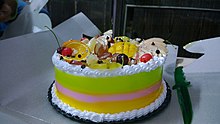eggnog pie
A punch cake is a particularly sweet cake that is flavored with rum . It is covered with a glaze and decorated. The name was derived from the drink of the same name, punch , which mainly consists of rum. Following the same principle, desserts punch in a form of cuts are made (eg. B. Punschkrapfen ).
Punch cakes can be detected in German cookbooks of the 19th century, also known as punch cake (English for punch cake) at Jules Gouffé when excluding rum and Curacao or arrack flavor ingredients were determined.
Manufacturing methods
For punch cakes one is Wiener floor two or three times cut apart (which three or four slices of pie crust yields), for punch desserts biscuit capsules (square biscuit plates) were used. The bottoms or capsules are soaked with rum potions , then filled, glazed and decorated (e.g. with chocolate decoration and cherries ). The capsules with filling can be cut rectangular or trapezoidal for desserts.
Punch fillings
In Germany, for punch filling, apricot jam with rum is stirred until the cake base or capsules are thinly coated. In Austria, a base for the punch filling is cut into cubes, mixed with chocolate or nut mass, rum and sugar syrup, then poured between two bases. The cakes and desserts are apricotized on the outside and the surface is partly covered with a thin marzipan coating before they are glazed and decorated.
Punch glazes
Punch cakes are glazed differently: in Germany, a white fondant glaze is common, in Austria the punch glaze is colored pink and flavored with rum.
Individual evidence
- ↑ a b c d Josef Loderbauer: The confectioner's book in learning fields. Sample pages: Confectioner - a craft profession. In: www.handwerk-technik.de. Retrieved May 29, 2019 .
- ↑ a b c d Alphabetical Technical Terms Lexicon Technical terms from N to P and their explanations. Europa-Lehrmittel , p. 37 , accessed on May 30, 2019 .
- ↑ Katharina Prato: The southern German cuisine on its current standpoint . Ed .: sosa2.uni-graz.at. Print and paper by A. Leykam's Erben, Graz 1858, p. 241 .
- ↑ F. Wyss: The confectionery in its full scope: textbook for the preparation of all work occurring in this art, patisserie, confectionery and preparation of the most popular drinks, liqueurs, frozen and crêmes . J. Heuberger's Verlag, 1866, p. 207–208 ( google.de [accessed May 30, 2019]).
- ^ Jules Gouffé: Le livre de pâtisserie / par Jules Gouffé, ...; ouvrage contenant 10 planches chromolithographiques et 137 gravures sur bois d'après les peintures à l'huile et les dessins de E. Ronjat . Ed .: Bibliothèque nationale de France. 1873, p. 239 ( bnf.fr [accessed May 30, 2019]).
- ↑ Friedr Luise Löffler: New Cookbook: or, Approved instructions for the tasty preparation of dishes, baked goods, confectionery, frozen foods and preserves . JF Steinkopf, 1833, p. 400 ( google.de [accessed on May 31, 2019]).
- ^ A b c Franz Maier-Bruck: The great Sacher cookbook . Wiener Verlag, 1975, p. 554, 564 .
